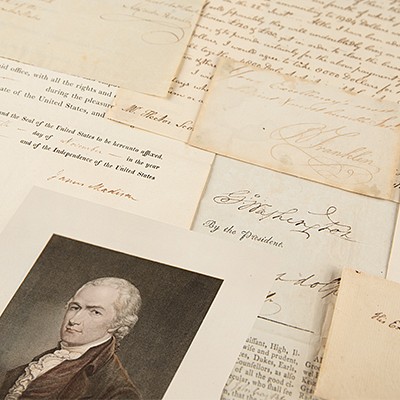Theodore Freeman's NASA Astronaut Group 3 Training Binder
Two ways to bid:
- Leave a max absentee bid and the platform will bid on your behalf up to your maximum bid during the live auction.
- Bid live during the auction and your bids will be submitted real-time to the auctioneer.
Bid Increments
| Price | Bid Increment |
|---|---|
| $0 | $5 |
| $50 | $10 |
| $200 | $25 |
| $500 | $50 |
About Auction
Oct 11, 2023
RR Auction support@rrauction.com
- Lot Description
Air Force pilot (1930-1964) selected as part of the third group of astronauts. He was killed on October 31, 1964, when a goose smashed through the cockpit canopy of his T-38 Talon jet trainer. He ejected from the aircraft but was too close to the ground for his parachute to open properly. Theodore Freeman’s personally-owned and -used training notebook, signed five times throughout in pencil, “Capt. T. C. Freeman, “T. C. Freeman,” or “Freeman,” undated, but very likely circa February-June 1964, a period that aligns with the Science Training Schedule for NASA’s Astronaut Group 3. This impressive ring-bound training binder, 10.5″ x 11.5″ x 3″, contains over 200 pages of handwritten notes, diagrams, and mathematical expressions, in addition to various tests, results, loose-leaf pages, and handouts, all of which feature significant annotations; virtually the entire binder is filled with double-sided pages of Freeman’s handwriting and navigational computations. Chapters include: Flight Mechanics (with sections for Free Flight Trajectories, Space Orbits, Inertial Guidance, Reentry Mechanics, Heating, Guidance and Control) and Aerodynamics (Orbital Mechanics, Burning Flight, Thrust Programming, and Radiative and Convective heating). A notable highlight can be found on a page marked “Stability,” which contains a Gemini capsule sketch with paragraphs related to damping, control, and stability derivatives. In overall fine condition. Training-used manuals from early NASA astronauts are exceedingly rare, with this example, deriving from the personal collection of Ted Freeman, whose astronautical career was cut tragically short, being among the very finest and most meticulous that we have ever seen or offered.
According to the 2001 book Gemini: Steps to the Moon by David Shayler, the astronauts of NASA Group 3 worked on “Flight Mechanics” and “Aerodynamics” during this five-month period, amounting to a total of 20 class sessions and 40 total hours. ‘The new Group 3 astronaut trainees embarked on the third round of academic studies, as had the sixteen astronauts before them. With the first manned Gemini missions fast approaching many of the first two groups of astronauts were becoming involved in preparations for their assignment to early flight crews, and were involved in Gemini mission training‰Û_In addition to completing their basic training program and receiving Gemini familiarization training and briefings, the fourteen new astronauts took more assignments in Apollo than had the previous groups, as many of them were expected to progress to Apollo missions.’ - Shipping Info
-
Bidder is liable for shipping and handling and providing accurate information as to shipping or delivery locations and arranging for such. RR Auction is unable to combine purchases from other auctions or affiliates into one package for shipping purposes. Lots won will be shipped in a commercially reasonable time after payment in good funds for the merchandise and the shipping fees are received or credit extended, except when third-party shipment occurs. Bidder agrees that service and handling charges related to shipping items which are not pre-paid may be charged to a credit card on file with RR Auction. Successful international Bidders shall provide written shipping instructions, including specified Customs declarations, to RR Auction for any lots to be delivered outside of the United States. NOTE: Declaration value shall be the item’(s) hammer price and RR Auction shall use the correct harmonized code for the lot. Domestic Bidders on lots designated for third-party shipment must designate the common carrier, accept risk of loss, and prepay shipping costs.
-
- Buyer's Premium



 EUR
EUR CAD
CAD AUD
AUD GBP
GBP MXN
MXN HKD
HKD CNY
CNY MYR
MYR SEK
SEK SGD
SGD CHF
CHF THB
THB
























